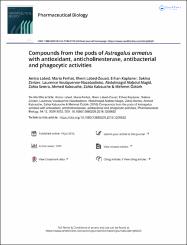Compounds from the pods of Astragalus armatus with antioxidant, anticholinesterase, antibacterial and phagocytic activities

Göster/
Tarih
2016Yazar
Labed, AmiraFerhat, Maria
Labed-Zouad, Ilhem
Kaplaner, Erhan
Zerizer, Sakina
Voutquenne-Nazabadioko, Laurence
Öztürk, Mehmet
Üst veri
Tüm öğe kaydını gösterÖzet
Context: The phytochemical study and biological activities of Astragalus armatus Willd. subsp. numidicus (Fabaceae) pods, an endemic shrub of Maghreb, are reported. Objective: This study isolates the secondary metabolites and determines the bioactivities of Astragalus armatus pods. Materials and methods: The chloroform, ethyl acetate and n-butanol extracts of hydro-ethanolic extracts were studied. Antioxidant activity was investigated using DPPH and ABTS radical scavenging, CUPRAC and ferrous chelating assays at concentrations ranging from 3 to 200 mu g/mL. Anticholinesterase activity was determined against acetylcholinesterase and butyrylcholinesterase enzymes at 50, 100 and 200 mu g/mL. Antibacterial activity was performed according to minimum inhibitory concentration (MIC) method. Carbon clearance method in albino mice was used for the phagocytic activity at concentrations 50, 70 and 100mg/kg body weight. Spectroscopic techniques were used to elucidate the compounds. Results: Ethyl acetate extract afforded a flavonoid (1) while the n-butanol extract gave four flavonoids (2-5), a cyclitol (6) and a cycloartane-type saponin (7). The ethyl acetate extract exhibited highest antioxidant activity in DPPH (IC50: 67.90 +/- 0.57 mu g/mL), ABTS (IC50: 11.30 +/- 0.09 mu g/mL) and CUPRAC (A(0.50): 50.60 +/- 0.9 mu g/mL) assays. The chloroform extract exhibited the best antibacterial activity against Staphylococcus aureus, Escherichia coli and Pseudomonas aeruginosa, each with 80 mu g/mL MIC values. The n-butanol extract enhanced phagocytic activity. Discussion and conclusion: Isorhamnetin (1), isorhamnetin-3-O-alpha-L-rhamnopyranosyl-(1 -> 6)-beta-D-galactopyranoside (2), isorhamnetin-3-O-beta-D-apiofuranosyl-(1 -> 2)-[alpha-L-rhamnopyranosyl-(1 -> 6)]-beta-D-galactopyranoside (3), kaempferol-3-O-(2,6-di-O-alpha-L-rhamnopyranosyl)-beta-D-galactopyranoside (4), kaempferol-3-O-(2,6-di-O-alpha-L-rhamnopyranosyl)- beta-D-glucopyranoside (5), pinitol (6) and cyclomacroside D (7) were isolated whereas 1, 2, 6 and 7 are reported for the first time from A. armatus.

















